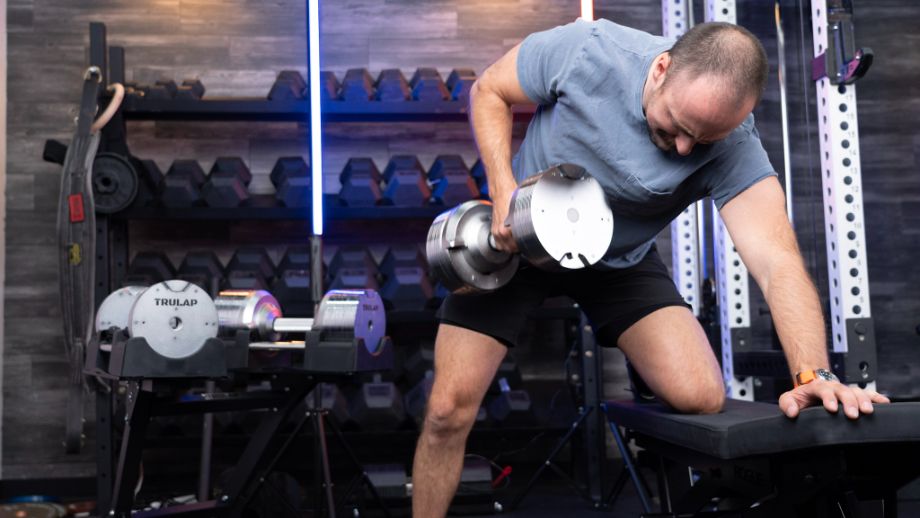We test and review fitness products based on an independent, multi-point methodology. If you use our links to purchase something, we may earn a commission. Read our disclosures.
Adding row exercises to your training regimen is fantastic for several reasons. The main reason is that they can help you build a thicker back and bigger biceps and improve your compound lifts. How? Because strong back muscles encourage good posture and support the spine, both of which are important during squats, deadlifts, bench presses, overhead presses, and more.
Based on my 10 years of weightlifting experience—as an enthusiast and certified personal trainer—I’ll go through my nine favorite row exercises step-by-step, give three sample row workouts, and then talk about back muscle anatomy. Without further ado, let’s get back into it.
9 Best Row Exercises
- Bent-Over Row
- Inverted Row
- One-Arm Dumbbell Row
- T-Bar Row
- Incline Bench Row
- Pendlay Row
- TRX Row
- Seated Cable Row
- Meadows Row
Bent-Over Row
Muscles worked: Latissimus dorsi, rhomboids, trapezius, posterior deltoids, lower back, hamstrings, glutes, biceps, forearms, core
Why do it: Barbell bent-over rows work your full body. Because of this, you can add heavier loads to the bar than you can with exercises such as one-arm dumbbell rows and incline bench rows, both of which you’ll see below. Regularly doing them will also improve your grip strength.
How to Do it:
- Place a loaded barbell on the ground.
- Step underneath the bar with your feet shoulder-width apart, similar to how you would with a deadlift.
- Squat down to take hold of the barbell with an overhand grip (palms facing the floor).
- Deadlift the bar to your pelvic region.
- Brace your core and push your hips back so the bar moves toward your knees.
- Row the bar toward your abdominal region, keeping your elbows tucked into your body.
- Pause momentarily, then slowly lower the barbell to the starting position.
- Continue for the desired number of reps.
Modifications
- Dial it back: Use dumbbells with a neutral grip if you’re uncomfortable training with a bar, and place less stress on your wrists.
- Make it harder: Try underhand or wide-grip barbell rows. The former hits the biceps and lower back to a greater extent, whereas the latter emphasizes the delts and trapezius.
Expert tip: To avoid injury, ensure that you have a slight bend in your knees and a neutral spine.
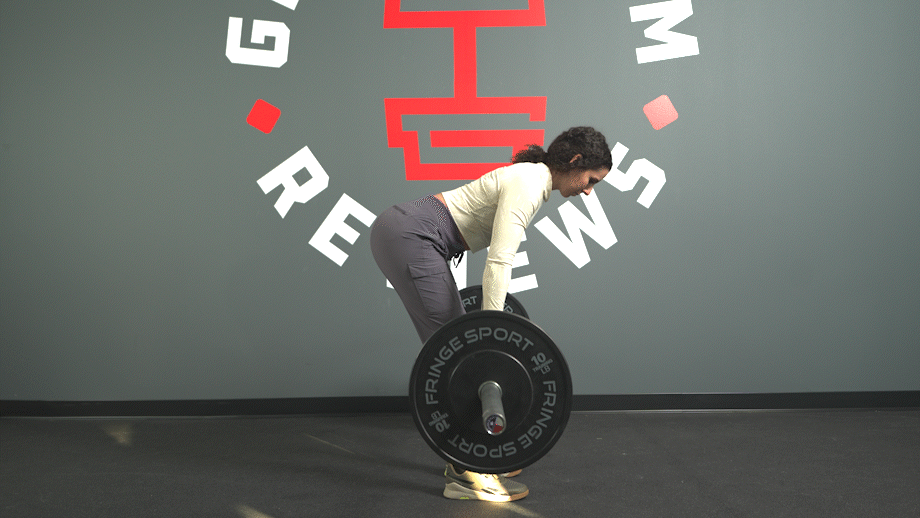
Inverted Row
Muscles worked: Latissimus dorsi, rhomboids, trapezius, posterior deltoids, lower back, hamstrings, glutes, biceps, forearms, core
Why do it: A 2016 study by the Journal of Strength and Conditioning Research1 found that inverted row exercises activated the latissimus dorsi, upper trapezius, middle trapezius, lower trapezius, and biceps brachii at “levels conducive to strengthening.” You can also do inverted rows from nearly anywhere since they only require your body weight.
How to Do it:
- Adjust a Smith machine or the J-hooks on one of the best squat racks so the bar is at hip height.
- Sit down on the floor underneath the barbell.
- Grab the bar with an overhand grip. You’ll want your arms to be straight and perpendicular to the bar.
- Walk your feet out until you’re comfortable (more on this below).
- Engage your core and pull your chest toward the bar without using your lower body.
- Hold before returning to the original position.
- Keep going for repetitions.
Modifications
- Dial it back: Start with your feet closer to your body so there’s a bend in your knees.
- Make it harder: The straighter your legs, the more difficult the exercise. You can also use rings instead of a bar to add an extra balance challenge.
Expert tip: You’ll want a straight line between your head and toes, and your hips mustn’t drop when you get tired.
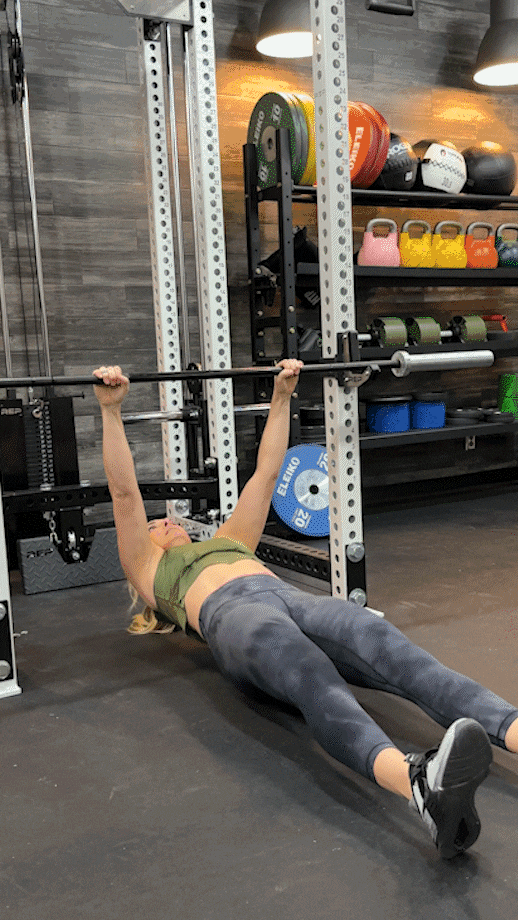
One-Arm Dumbbell Row
Muscles worked: Latissimus dorsi, rhomboids, trapezius, posterior deltoids, biceps, forearms, core
Why do it: Single-arm dumbbell rows are a unilateral exercise that can help strengthen and correct muscular imbalances. You may also find that holding the dumbbell with a neutral grip places less strain on the wrists than other row exercises.
How to Do it:
- Put your right knee and right hand on a flat bench. Stabilize yourself using your body weight.
- Place your left foot flat on the floor, ensuring that your toes are facing forward and there’s a slight bend in your left knee.
- Pick the dumbbell off the floor with your left hand. You’ll want your left arm to be straight.
- Row the dumbbell toward your left hip, pausing at the top.
- Lower the dumbbell back to the hanging position in a controlled manner.
- Repeat for reps, then switch to the opposite side.
Expert tip: Pick a weight that allows you to get a full range of motion—anything less, and you’re losing out on potential gains.
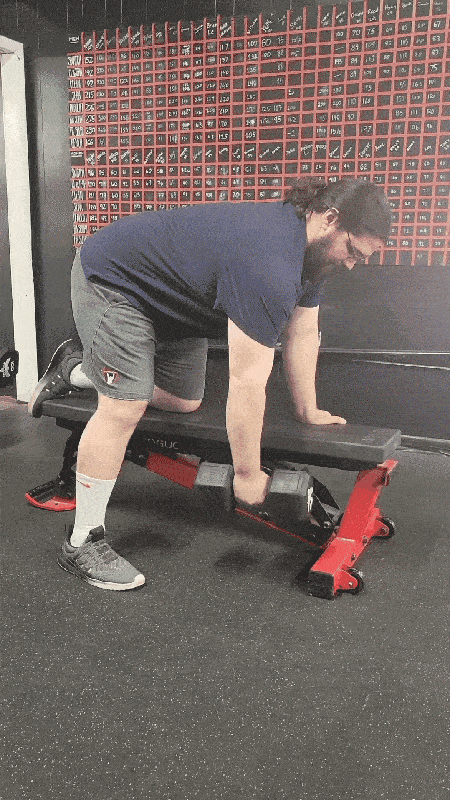
T-Bar Row
Muscles worked: Latissimus dorsi, rhomboids, trapezius, posterior deltoids, lower back, hamstrings, glutes, biceps, forearms, core
Why do it: You’ll activate similar muscle groups to bent-over rows (which you saw above), but the main difference is that the bar stays on a fixed path because you use a landmine setup. You also use your core to a lesser extent, which may result in you lifting heavier loads.
How to Do it:
- Place one end of a barbell into a landmine base.
- Add weight plates to the other end of the Olympic bar.
- Stand in a wide stance facing away from the landmine attachment. You’ll want the bar to be between your legs.
- Squat down to take hold of the attachment if you’re using one. If not, wrap both hands around the bar, one on top of the other.
- Lift the bar off the floor slightly, ensuring that your arms are extended.
- Lift your chest up and tense your core before pulling the bar toward your abdominal region.
- Pause, then lower the bar to the starting position.
- Row for reps.
Expert tip: The V-bar attachment is the most common used for T-bar rows but experiment with different attachments to find one that works.
RELATED: Best Olympic Bar
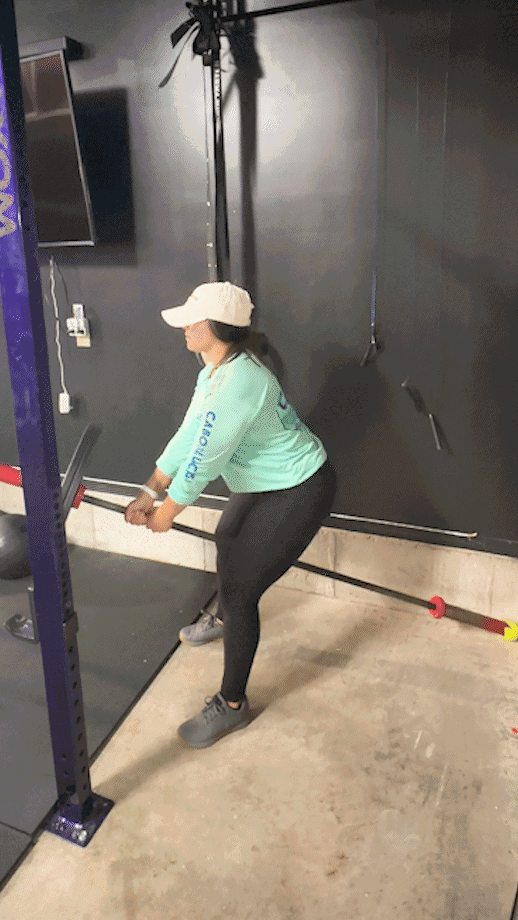
Incline Bench Row
Muscles worked: Latissimus dorsi, rhomboids, trapezius, posterior deltoids, biceps, forearms, core
Why do it: I love incline bench rows (aka chest-supported rows) because they isolate your lats and upper back muscles. You’ll need to decrease the load you lift, but there’s no way you can do cheat reps because your chest is firm against the bench throughout.
How to Do it:
- Place a pair of dumbbells on either side of an incline bench.
- Sit down on the bench with your chest against the backrest.
- Grab the dumbbells with a neutral grip (palms facing each other) and arms straight.
- Retract your shoulder blades, then row the dumbbells to your hips. You’ll want to lead with your elbows.
- Lower the weights to the original position in a controlled manner.
- Keep going for the desired number of repetitions.
Expert tip: If you’re dropping your dumbbells too quickly at the end of the movement or can’t hold at the top, you need to lower your weight.
RELATED: Best Dumbbells
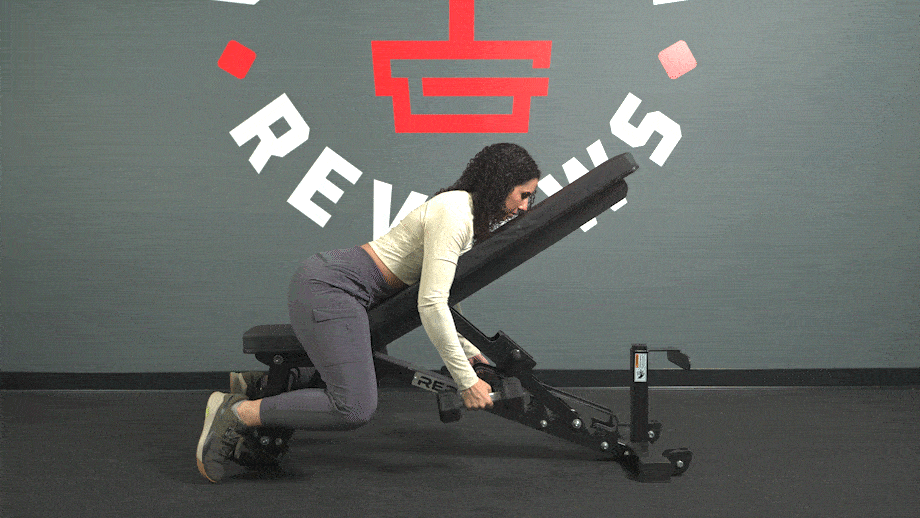
Pendlay Row
Muscles worked: Latissimus dorsi, rhomboids, trapezius, posterior deltoids, lower back, hamstrings, glutes, biceps, forearms, core
Why do it: You won’t be able to lift as heavy on Pendlay rows as you can with bent-over and T-bar rows (both of which I shared above). However, because the bar comes to a stop after every rep, you’ll improve your explosive power, which can help with the clean and jerk and snatch exercise.
How to Do it:
- Place a loaded barbell on the ground.
- Step underneath the bar with your feet shoulder-width apart. You’ll want the barbell to be covering your shoelaces.
- Bend your knees slightly, then hinge at your hips so your chest moves toward the floor.
- Hold the bar with an overhand grip. Your hands should be positioned slightly wider than shoulder-width apart.
- Brace your core, engage your lats, and pull the bar toward your abdominal region.
- Return the bar to the floor slowly so it’s at a dead stop.
- Repeat for reps.
Modifications
- Dial it back: Use two kettlebells instead of a barbell to reduce your range of motion.
- Make it harder: Stand on a weight plate or a raised platform to do a deficit Pendlay row, helping to maximize your muscles’ time under tension (TUT).
Expert tip: You’ll need to keep your chest parallel to the floor to make the most out of this movement.
RELATED: Best Weight Plates
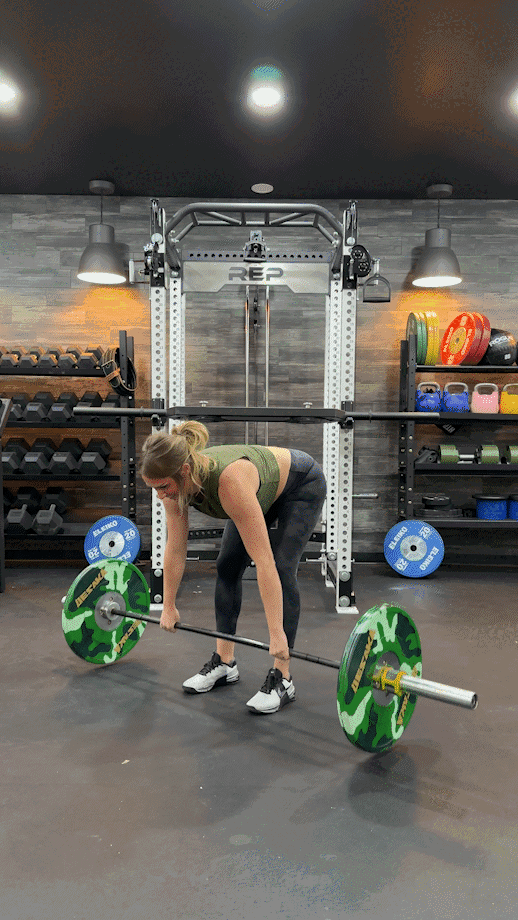
TRX Row
Muscles worked: Latissimus dorsi, rhomboids, trapezius, posterior deltoids, lower back, hamstrings, glutes, biceps, forearms, core
Why do it: TRX rows have similar benefits to inverted rows (seen above). However, I prefer TRX rows because you can have a neutral rather than an overhand grip. You may find that regularly doing them strengthens your pull-ups, too.
How to Do it:
- Adjust the TRX so the handles are at chest height.
- Grasp the handles and take a step or two backward to create tension.
- Lean back to a comfortable level (more on this below), ensuring your arms are straight.
- Engage your core, keep your head neutral, and pull yourself toward the ceiling. You’ll want to keep your elbows close to your body.
- Hold for a moment, then lower yourself down with control.
- Row for repetitions.
Modifications
- Dial it back: Start with your body more vertically to make the exercise easier.
- Make it harder: Step your feet forward and get your body closer to parallel to the ground.
Expert tip: If the above is too easy, even with your body parallel to the floor, try single-arm TRX rows instead.
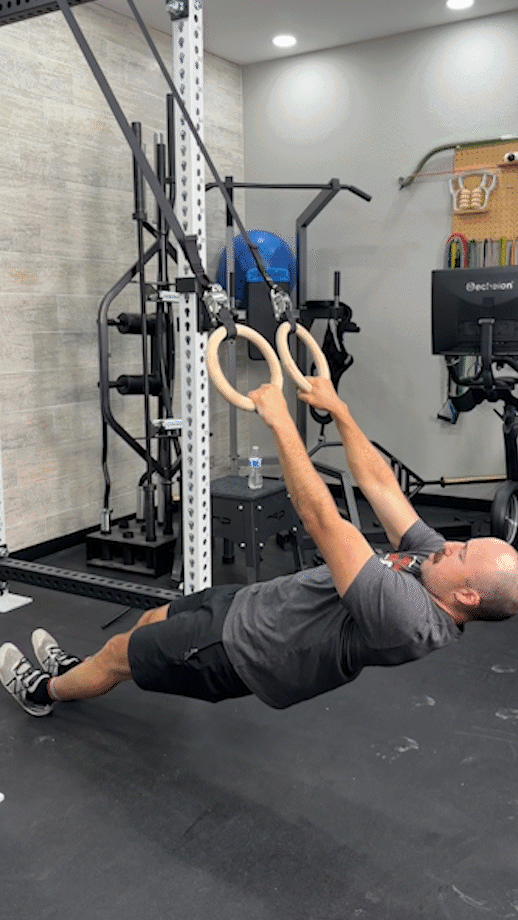
Seated Cable Row
Muscles worked: Latissimus dorsi, rhomboids, trapezius, posterior deltoids, biceps, forearms, core
Why do it: Training with cables has multiple benefits, including safety, versatility, and constant tension on the muscles. If you’re new to training or uncomfortable with the barbell and dumbbell row exercises on this list, adding the seated cable row to your routine is a fantastic idea.
How to Do it:
- Select the appropriate weight and attachment.
- Adjust the pulley so it’s at chest height when you’re seated on a bench or the ground.
- Sit upright with your feet on the pads and a slight bend in your knees.
- Grab the attachment, ensuring that your arms are extended.
- Retract your shoulder blades, lift your chest up, and row the attachment into your abdominal region.
- Pause before slowly returning the attachment to the starting position.
- Continue for reps.
Expert tip: Try different attachments (V-bar, straight bar, wide bar, or rope) to work your back muscles in slightly different ways.
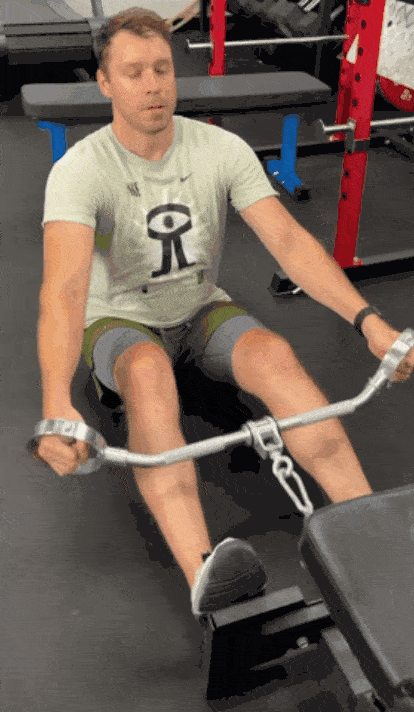
Meadows Row
Muscles worked: Latissimus dorsi, rhomboids, trapezius, posterior deltoids, lower back, hamstrings, glutes, biceps, forearms, core
Why do it: Like the one-arm dumbbell row, Meadows rows are a unilateral exercise that can address bilateral deficits2. Grabbing the end of the barbell where it’s the thickest also helps improve your grip strength.
How to Do it:
- Place a barbell into a landmine attachment. Add weight plates to the other end.
- Stand perpendicular to the bar, with your left foot in front of your right foot.
- Bend forward and grab the end of the bar with your right hand. Adjust your feet if necessary.
- Place your left forearm on your left quadricep to help with stability.
- Tense your core and pull the bar toward your right hip and hold at the top of the movement.
- Return the bar to the floor in a controlled manner.
- Repeat for repetitions, then switch to the other side.
Expert tip: Only your arm should move during this exercise—the rest of your body must stay fixed.
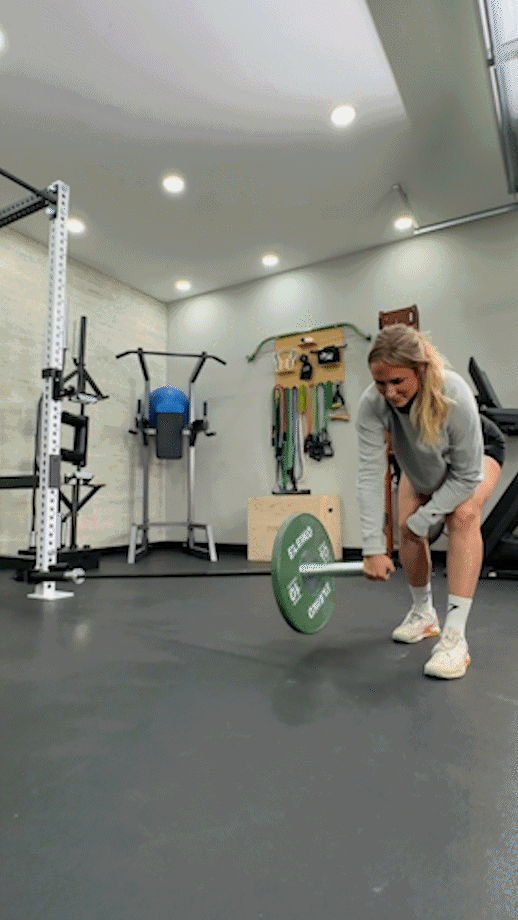
Sample Row Workouts
Now that I’ve shared the nine best row exercises, you can incorporate them into your next back-focused workout. Below are three sample row workouts for beginners to gain muscle size and increase strength that I would recommend to a client:
Row Workout for Beginners
For beginners, there’s a bodyweight exercise, a dumbbell exercise, and a cable exercise. If you don’t have a TRX, swap TRX rows for inverted rows. You can use a cable machine for seated cable rows if your gym doesn’t have a dedicated machine.
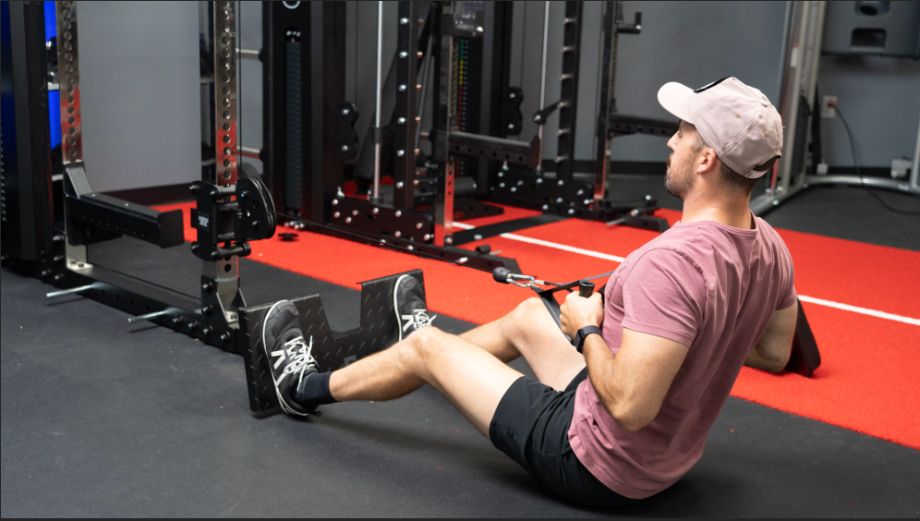
To warm up, jog for a few minutes, then do dynamic exercises such as arm circles and swings, jumping jacks, pull-aparts, and more.
| Exercise | Sets | Reps |
| TRX Row | 4 | 6 |
| Incline Bench Row | 3 | 8 |
| Seated Cable Row | 3 | 10 |
Equipment needed: A TRX suspension system, a pair of dumbbells, an incline bench, and a seated cable row machine.
RELATED: TRX Coupon Code
Row Workout for Hypertrophy
To gain size (aka hypertrophy), we’ll increase the number of exercises and sets. Perform lighter sets of bent-over and one-arm dumbbell rows before progressing to heavier weights. You can swap bent-over rows for T-bar or Pendlay rows because all three exercises work the same muscle groups.
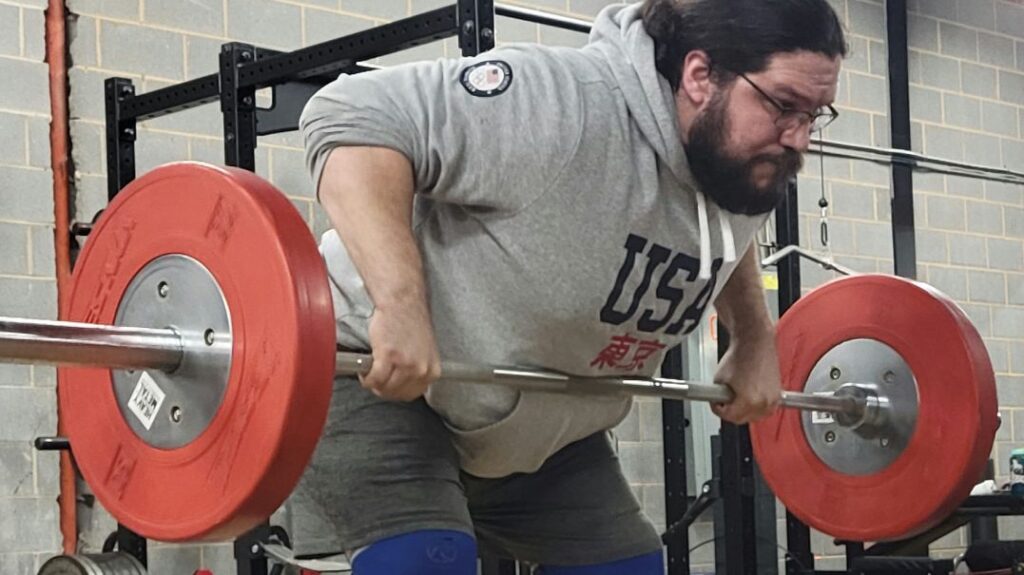
Jog for a few minutes and do some dynamic exercises before you start.
| Exercise | Sets | Reps |
| Inverted Row | 4 | 6 |
| Bent-Over Row | 4 | 8 |
| One-Arm Dumbbell Row | 4 | 10 |
| Seated Cable Row | 4 | 12 |
Equipment needed: You’ll need access to a Smith machine or squat rack, a barbell and weight plates, a pair of dumbbells, a flat bench, and a seated cable row machine.
Row Workout for Strength
To increase your strength, you’ll want to pick three different row exercises and do four sets of each. Each set will have five reps, allowing you to lift heavier weights (around 85% to 90% of your one-rep max).
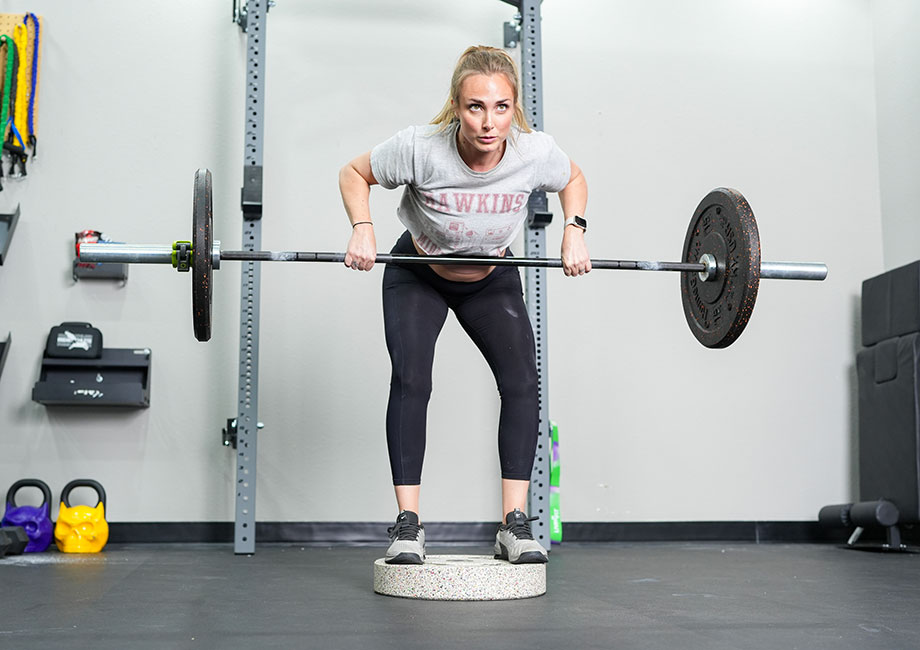
Swap Pendlay rows for T-bar rows or bent-over rows if you wish, and do a similar warm-up to what I described above.
| Exercise | Sets | Reps |
| Pendlay Row | 4 | 5 |
| Meadows Row | 4 | 5 |
| One-Arm Dumbbell Row | 4 | 5 |
Equipment needed: A barbell and weight plates, a landmine attachment, a pair of dumbbells, and a flat bench.
What Muscles Make Up Your Back?
Let’s discuss back anatomy and the importance of working your back muscles. Doing so may improve your posture, support your spine, and reduce pain. This can make everyday life easier and enhance performance in the gym. Below are the four main muscles that make up the back:
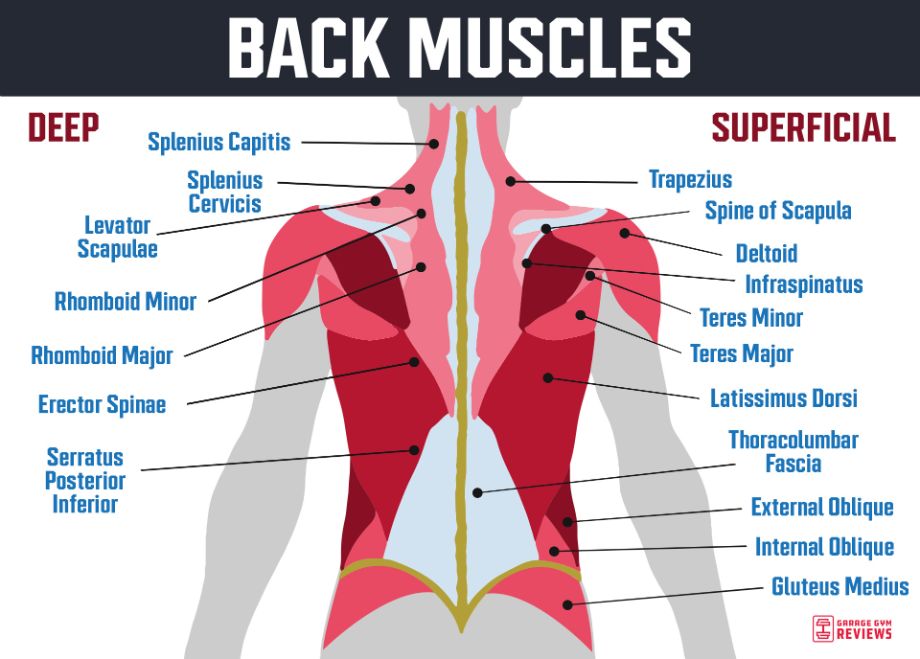
- Latissimus Dorsi: The latissimus dorsi works with the teres major and pectoralis major to adduct, medially rotate, and extend the arm at the glenohumeral joint3. It’s also an accessory muscle of respiration.
- Rhomboids: The rhomboids are important in upper limb movement and stability of both the shoulder girdle and scapula4.
- Trapezius: The function of the trapezius is to stabilize and move the scapula5.
- Posterior Deltoids: Throughout abduction, the posterior deltoid works with the anterior deltoid to stabilize the arm, and it also works with the latissimus dorsi to extend the arm during ambulation6.
Benefits of Row Exercises
A thicker back, bigger biceps, and improved compound lifts are the main benefits of adding row exercises to your workout routine. Let me elaborate:
Build A Thicker Back
Since beginning training over 10 years ago, I’ve been impressed with thick and symmetrical backs. Upper back exercises such as pull-ups and lat pulldowns are great, and combining them with row variations such as those listed above can make all of the difference in developing a thicker back.
Craft Bigger Biceps
Although row exercises are found in back workouts, they also hit the biceps. This is especially the case when you’re lifting heavy weights. As a certified personal trainer (CPT), I advise my clients to limit their biceps exercises in their first year of training and focus on getting stronger on compound exercises such as barbell rows, one-arm dumbbell rows, Pendlay rows, and more.
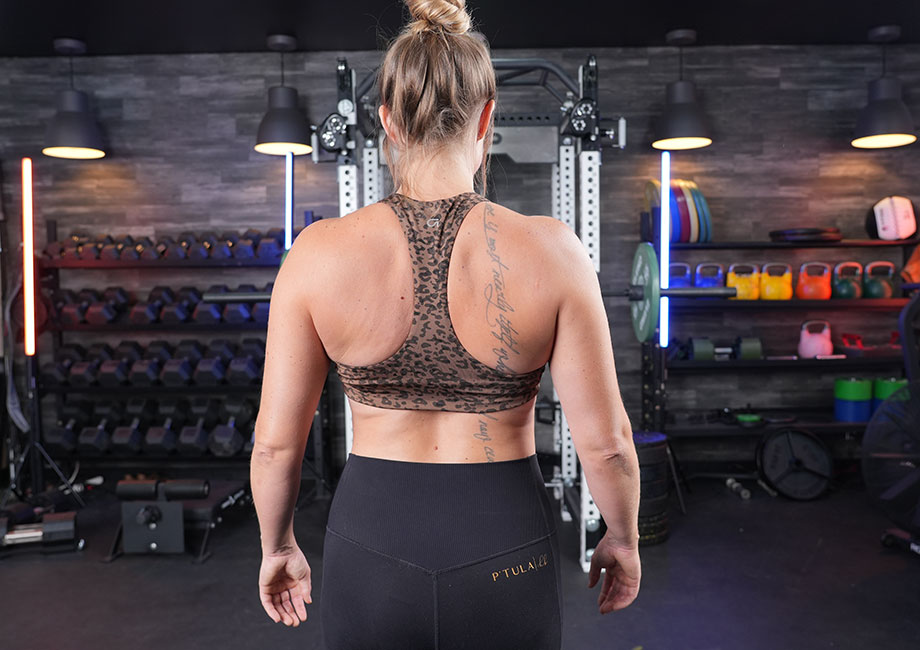
Improve Your Compound Lifts
Increasing your back strength can carry over to other weightlifting exercises such as bench presses, overhead presses, squats, deadlifts, and more. Your chest and back are opposing muscle groups, so a weak back will limit your chest development. You’re less likely to get injured during these lifts too because a strong back helps to prevent your spine from rounding.
Row Exercises: Final Thoughts
It’s worth trying all of the above row exercises to see which work for you (and which don’t!). Of course, if you’re limited in terms of equipment, this may not be possible. You’ll soon find three or four exercises that you keep going back to time and time again. Doing these regularly will help you build a thicker back and bigger biceps, and may improve other compound lifts. Above all, remember to get your form correct before lifting heavy weights.
Row Exercises: FAQs
What is the best row exercise?
Examples of excellent row exercises that I recommend to my personal training clients includes:
– Bent-Over Rows
– Inverted Rows
– One-Arm Dumbbell Rows
– T-Bar Rows
– Incline Bench Rows
– Pendlay Rows
– TRX Rows
– Seated Cable Rows
– Meadows Rows
Everyone is different, so try them to find the best row exercise for your needs. I enjoy bent-over rows, inverted rows, and seated cable rows.
What muscles do rows work?
Rows mainly work the muscles in the back (lats, rhomboids, traps, and posterior deltoids) and the biceps. However, depending on the exercise, you may also hit additional muscle groups, including the hamstrings, glutes, lower back, forearms, and core.
Do rows burn belly fat?
Rows can help burn belly fat because doing exercise burns calories. The other benefit of performing rows is increasing your muscle mass, which is ideal because the more muscle you have, the more calories you burn at rest.
However, there’s more to it if weight loss is your goal—you’ll need proper nutrition and to be in a calorie deficit.
References
- Youdas JW, Keith JM, Nonn DE, Squires AC, Hollman JH. Activation of Spinal Stabilizers and Shoulder Complex Muscles During an Inverted Row Using a Portable Pull-up Device and Body Weight Resistance. J Strength Cond Res. 2016 Jul;30(7):1933-41. doi: 10.1519/JSC.0000000000001210. PMID: 26422610.
- Škarabot J, Cronin N, Strojnik V, Avela J. Bilateral deficit in maximal force production. Eur J Appl Physiol. 2016 Dec;116(11-12):2057-2084. doi: 10.1007/s00421-016-3458-z. Epub 2016 Aug 31. PMID: 27582260.
- Jeno SH, Varacallo M. Anatomy, Back, Latissimus Dorsi. [Updated 2023 Mar 5]. In: StatPearls [Internet]. Treasure Island (FL): StatPearls Publishing; 2024 Jan-. Available from: https://www.ncbi.nlm.nih.gov/books/NBK448120/
- Farrell C, Kiel J. Anatomy, Back, Rhomboid Muscles. [Updated 2023 May 16]. In: StatPearls [Internet]. Treasure Island (FL): StatPearls Publishing; 2024 Jan-. Available from: https://www.ncbi.nlm.nih.gov/books/NBK534856/
- Ourieff J, Scheckel B, Agarwal A. Anatomy, Back, Trapezius. [Updated 2023 Mar 11]. In: StatPearls [Internet]. Treasure Island (FL): StatPearls Publishing; 2024 Jan-. Available from: https://www.ncbi.nlm.nih.gov/books/NBK518994/
- Elzanie A, Varacallo M. Anatomy, Shoulder and Upper Limb, Deltoid Muscle. [Updated 2024 Jan 30]. In: StatPearls [Internet]. Treasure Island (FL): StatPearls Publishing; 2024 Jan-. Available from: https://www.ncbi.nlm.nih.gov/books/NBK537056/
Further reading

It’s the battle of cycling bikes: MYX vs Peloton. Which exercise bike should you buy for your home gym? We’ll tell you. Read more

This simple, compact cold plunge tub is durable enough for the outdoors. FInd out more in this Redwood Outdoors Alaskan Cold Plunge review. Read more

It’s the clash of two incline trainer treadmills in the NordicTrack 2950 vs X22i comparison. Read more

Current or former military members can score big-time savings on shoes, apparel, and more by taking advantage of the Reebok military discount program. Read more

